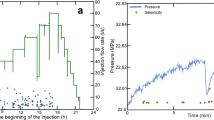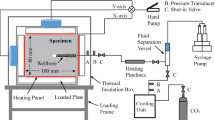Abstract
The low permeability of gas hydrate deposits leads to poor extraction rates. Artificial fracture stimulation could significantly improve the recovery rate of an estimated 300 trillion m3 of this untapped future energy source, which form in seabed sedimentary deposits. Because conventional methods of rock fragmentation are inapplicable in such deposits due to sudden release of energy that may impose the risk of methane release to the atmosphere, alternative rock fragmentation technologies are necessary for artificial fracture stimulation of gas hydrate deposits. We checked the effectiveness of a new hydrophobic non-explosive demolition agent as a rock fracturing technique, which could potentially be used as a third-generation disruptive technology for mining (3G-DTM). Laboratory experiments performed by mimicking deep-sea environments suggest that the density of the gradually generated rock mass fractures increases with confining pressure and pore fluid salinity. Importantly, due to the fracturing nature of 3G-DTM, the fracture density can be significantly improved (by 116%) with increasing the confining pressure (from 70 kPa to 20 MPa). Increased salinity of the rock pore fluid also improved the fracture density by 38% at 20 MPa confining pressure when the salinity increased from 0% to 20%. Furthermore, the rock is subjected to a gradual fracturing process in the 3G-DTM fracturing (10–15 h in the laboratory experiments) allowing for a safer, more controlled fracture propagation, making 3G-DTM a substitute for conventional rock fragmentation in marine environments.















Similar content being viewed by others
Notes
1 BTU = 1055 J.
References
Al-Shayea, N. A., Khan, K., & Abduljauwad, S. N. (2000). Effects of confining pressure and temperature on mixed-mode (I–II) fracture toughness of a limestone rock. International Journal of Rock Mechanics and Mining Sciences, 37(4), 629–643. https://doi.org/10.1016/S1365-1609(00)00003-4.
Archer, D., Buffett, B., & Brovkin, V. (2009). Ocean methane hydrates as a slow tipping point in the global carbon cycle. Proceedings of the National Academy of Sciences, 106(49), 20596–20601.
Bird, M., Butler, S. L., Hawkes, C., & Kotzer, T. (2014). Numerical modeling of fluid and electrical currents through geometries based on synchrotron X-ray tomographic images of reservoir rocks using Avizo and COMSOL. Computers & Geosciences, 73, 6–16.
Boswell, R. (2007). Resource potential of methane hydrate coming into focus. Journal of Petroleum Science and Engineering, 56(1), 9–13. https://doi.org/10.1016/j.petrol.2006.09.002.
Boswell, R. (2009). Is gas hydrate energy within reach? Science, 325(5943), 957–958. https://doi.org/10.1126/science.1175074.
Boswell, R., & Collett, T. S. (2011). Current perspectives on gas hydrate resources. Energy & Environmental Science, 4(4), 1206–1215.
Brown, S. R. (1987). Fluid flow through rock joints: The effect of surface roughness. Journal of Geophysical Research: Solid Earth, 92(B2), 1337–1347. https://doi.org/10.1029/JB092iB02p01337.
Brown, P. J., Sanders, R., McDonagh, E., Henson, S., Best, A. I., Poulton, A. J., et al. (2016). 4.2 Impacts and effects of ocean warming on carbon management including methane hydrates. In Explaining ocean warming: Causes, scale, effects and consequences, p. 373.
Chen, C.-T. A., & Marshall, W. L. (1982). Amorphous silica solubilities IV. Behavior in pure water and aqueous sodium chloride, sodium sulfate, magnesium chloride, and magnesium sulfate solutions up to 350 °C. Geochimica et Cosmochimica Acta, 46(2), 279–287. https://doi.org/10.1016/0016-7037(82)90255-1.
Chen, J. J., Thomas, J. J., Taylor, H. F., & Jennings, H. M. (2004). Solubility and structure of calcium silicate hydrate. Cement and Concrete Research, 34(9), 1499–1519.
Chong, Z. R., Yang, S. H. B., Babu, P., Linga, P., & Li, X.-S. (2016). Review of natural gas hydrates as an energy resource: Prospects and challenges. Applied Energy, 162, 1633–1652. https://doi.org/10.1016/j.apenergy.2014.12.061.
Collett, T. S. (1993). Natural gas hydrates of the Prudhoe Bay and Kuparuk River area, North Slope, Alaska. AAPG Bulletin, 77(5), 793–812.
Collett, T. S., Johnson, A. H., Knapp, C. C., & Boswell, R. (2009). Natural gas hydrates: A review.
Cook, A., Myer, L., Cook, N., & Doyle, F. (1990). The effects of tortuosity on flow through a natural fracture. In W. Hustrulid & G. A. Johnson (Eds.), Rock mechanics contributions and challenges: Proceedings of the 31st US symposium on rock mechanics (pp. 371–378). Rotterdam: Balkema
De Silva, V. R. S., Ranjith, P. G., Perera, M. S. A., & Wu, B. (2018a). Micro-mechanics based numerical simulation of NaCl brine induced mechanical strength deterioration of sedimentary host-rock formations. Engineering Geology, 242, 55–69.
De Silva, V. R. S., Ranjith, P. G., Perera, M. S. A., Wu, B., & Rathnaweera, T. D. (2017). Investigation of the mechanical, microstructural and mineralogical morphology of soundless cracking demolition agents during the hydration process. Materials Characterization, 130, 9–24.
De Silva, V. R. S., Ranjith, P. G., Perera, M. S. A., Wu, B., & Rathnaweera, T. D. (2018b). A modified, hydrophobic soundless cracking demolition agent for non-explosive demolition and fracturing applications. Process Safety and Environmental Protection, 119, 1–13. https://doi.org/10.1016/j.psep.2018.07.010.
De Silva, V. R. S., Ranjith, P. G., Perera, M. S. A., Wu, B., & Rathnaweera, T. D. (2018c). The influence of admixtures on the hydration process of soundless cracking demolition agents (SCDA) for fragmentation of saturated deep geological reservoir rock formations. Materials Characterization, 130(9–24), 16
De Silva, V. R. S., Ranjith, P. G., Perera, M. S. A., Wu, B., & Wanniarachchia, W. A. M. (2018d). A low energy rock fragmentation technique for in-situ leaching. Journal of Cleaner Production, 204, 586–606.
Demirbas, A. (2010a). Methane gas hydrate: As a natural gas source. Berlin: Springer.
Demirbas, A. (2010b). Methane hydrates as potential energy resource: Part 1—Importance, resource and recovery facilities. Energy Conversion and Management, 51(7), 1547–1561. https://doi.org/10.1016/j.enconman.2010.02.013.
Dowding, C. H., & Labuz, J. F. (1983). Closure to “Fracturing of Rock with Expansive Cement” by Charles H. Dowding and Joseph F. Labuz (October, 1982). Journal of Geotechnical Engineering, 109(9), 1208–1209. https://doi.org/10.1061/(ASCE)0733-9410(1983)109:9(1208).
EIA. (2016). International Energy Outlook 2016. Washingon: Energy Information Administration.
Funatsu, T., Kuruppu, M., & Matsui, K. (2014). Effects of temperature and confining pressure on mixed-mode (I–II) and mode II fracture toughness of Kimachi sandstone. International Journal of Rock Mechanics and Mining Sciences, 67(Supplement C), 1–8. https://doi.org/10.1016/j.ijrmms.2013.12.009.
Ghassemi, A., & Pak, A. (2011). Pore scale study of permeability and tortuosity for flow through particulate media using Lattice Boltzmann method. International Journal for Numerical and Analytical Methods in Geomechanics, 35(8), 886–901. https://doi.org/10.1002/nag.932.
Harada, T., Soeda, K., Idemitsu, T., & Watanabe, A. (1993). Characteristics of expansive pressure of an expansive demolition agent and the development of new pressure transducers. In Proceedings-Japan Society of Civil Engineers, 1993 (pp. 91–91). Dotoku Gakkai.
Hinze, J., & Brown, J. (1994). Properties of soundless chemical demolition agents. Journal of construction Engineering and Management, 120(4), 816–827.
Huynh, M. P., Laefer, D. F., McGuill, J., & White, A. (2017). Temperature-related performance factors for chemical demolition agents. International Journal of Masonry Research and Innovation, 2(2–3), 220–240.
Ji, C., Ahmadi, G., & Smith, D. H. (2001). Natural gas production from hydrate decomposition by depressurization. Chemical Engineering Science, 56(20), 5801–5814.
Klar, A., Soga, K., & Ng, M. (2010). Coupled deformation–flow analysis for methane hydrate extraction. Geotechnique, 60(10), 765–776.
Makogon, Y. F., Holditch, S. A., & Makogon, T. Y. (2007). Natural gas-hydrates—A potential energy source for the 21st Century. Journal of Petroleum Science and Engineering, 56(1), 14–31. https://doi.org/10.1016/j.petrol.2005.10.009.
Milad, B., & Slatt, R. (2018). Impact of lithofacies variations and structural changes on natural fracture distributions. Interpretation, 6(4), 1–51.
Milkov, A. V. (2004). Global estimates of hydrate-bound gas in marine sediments: How much is really out there? Earth-Science Reviews, 66(3), 183–197. https://doi.org/10.1016/j.earscirev.2003.11.002.
Mohr, S. H., Wang, J., Ellem, G., Ward, J., & Giurco, D. (2015). Projection of world fossil fuels by country. Fuel, 141(Supplement C), 120–135. https://doi.org/10.1016/j.fuel.2014.10.030.
Nam, Y., Kim, K., Park, S., Sohn, D., & Lee, J. (2015). Arrangement of agent holes for enhancing crack propagation in structure demolition process using soundless chemical demolition agents. Journal of the Computational Structural Engineering Institute of Korea, 28(6), 683–690.
Natanzi, A. S., Laefer, D. F., & Connolly, L. (2016). Cold and moderate ambient temperatures effects on expansive pressure development in soundless chemical demolition agents. Construction and Building Materials, 110, 117–127.
Newton, R. C., & Manning, C. E. (2004). Solubility of anhydrite, CaSO4, in NaCl–H2O solutions at high pressures and temperatures: Applications to fluid–rock interaction. Journal of Petrology, 46(4), 701–716.
Ni, X., Miao, J., Lv, R., & Lin, X. (2017). Quantitative 3D spatial characterization and flow simulation of coal macropores based on μCT technology. Fuel, 200, 199–207.
Olah, G. A. (2005). Beyond oil and gas: The methanol economy. Angewandte Chemie International Edition, 44(18), 2636–2639.
Rathnaweera, T., Ranjith, P., & Perera, M. (2014). Salinity-dependent strength and stress–strain characteristics of reservoir rocks in deep saline aquifers: An experimental study. Fuel, 122, 1–11.
Shukla, R., Ranjith, P. G., Choi, S. K., Haque, A., Yellishetty, M., & Hong, L. (2013). Mechanical behaviour of reservoir rock under brine saturation. Rock Mechanics and Rock Engineering, 46(1), 83–93. https://doi.org/10.1007/s00603-012-0246-x.
Smith, C. A., Guido DeHoratiis, J., Boswell, R. M., Duda, J. R., Yost, A. B., & Long, R. (2011). Energy resource potential of methane hydrate (pp. 4–23). US Department of Energy.
Sung, W., Lee, H., Lee, H., & Lee, C. (2002). Numerical study for production performances of a methane hydrate reservoir stimulated by inhibitor injection. Energy Sources, 24(6), 499–512. https://doi.org/10.1080/00908310290086527.
Tang, S., Huang, R., Wang, S., Bao, C., & Tang, C. (2017). Study of the fracture process in heterogeneous materials around boreholes filled with expansion cement. International Journal of Solids and Structures, 112, 1–15.
Tang, L. G., Xiao, R., Huang, C., Feng, Z., & Fan, S. S. (2005). Experimental investigation of production behavior of gas hydrate under thermal stimulation in unconsolidated sediment. Energy & Fuels, 19(6), 2402–2407.
Taud, H., Martinez-Angeles, R., Parrot, J. F., & Hernandez-Escobedo, L. (2005). Porosity estimation method by X-ray computed tomography. Journal of Petroleum Science and Engineering, 47(3–4), 209–217. https://doi.org/10.1016/j.petrol.2005.03.009.
Tsang, Y. (1984). The effect of tortuosity on fluid flow through a single fracture. Water Resources Research, 20(9), 1209–1215.
Xu, J., Zhai, C., Qin, L., & Yu, G. (2017). Evaluation research of the fracturing capacity of non-explosive expansion material applied to coal-seam roof rock. International Journal of Rock Mechanics and Mining Sciences, 94(Supplement C), 103–111. https://doi.org/10.1016/j.ijrmms.2017.03.004.
Yamamoto, K., Nakatsuka, Y., Sato, R., Kvalstad, T., Qiu, K., & Birchwood, R. (2015). Geohazard risk evaluation and related data acquisition and sampling program for the methane hydrate offshore production test. In Proceedings of the 3rd international symposium on frontiers in offshore geotechnics: ISFOG 2015, 2015 (pp. 173–181).
Acknowledgments
This work was supported by the Multi-modal Australian ScienceS Imaging and Visualisation Environment (MASSIVE) (www.massive.org.au) and the CT scanning was performed on the Imaging and Medical beamline at the Australian Synchrotron, part of ANSTO.
Author information
Authors and Affiliations
Corresponding author
Rights and permissions
About this article
Cite this article
De Silva, V.R.S., Ranjith, P.G., Perera, M.S.A. et al. Artificial Fracture Stimulation of Rock Subjected to Large Isotropic Confining Stresses in Saline Environments: Application in Deep-Sea Gas Hydrate Recovery. Nat Resour Res 28, 563–583 (2019). https://doi.org/10.1007/s11053-018-9409-0
Received:
Accepted:
Published:
Issue Date:
DOI: https://doi.org/10.1007/s11053-018-9409-0




